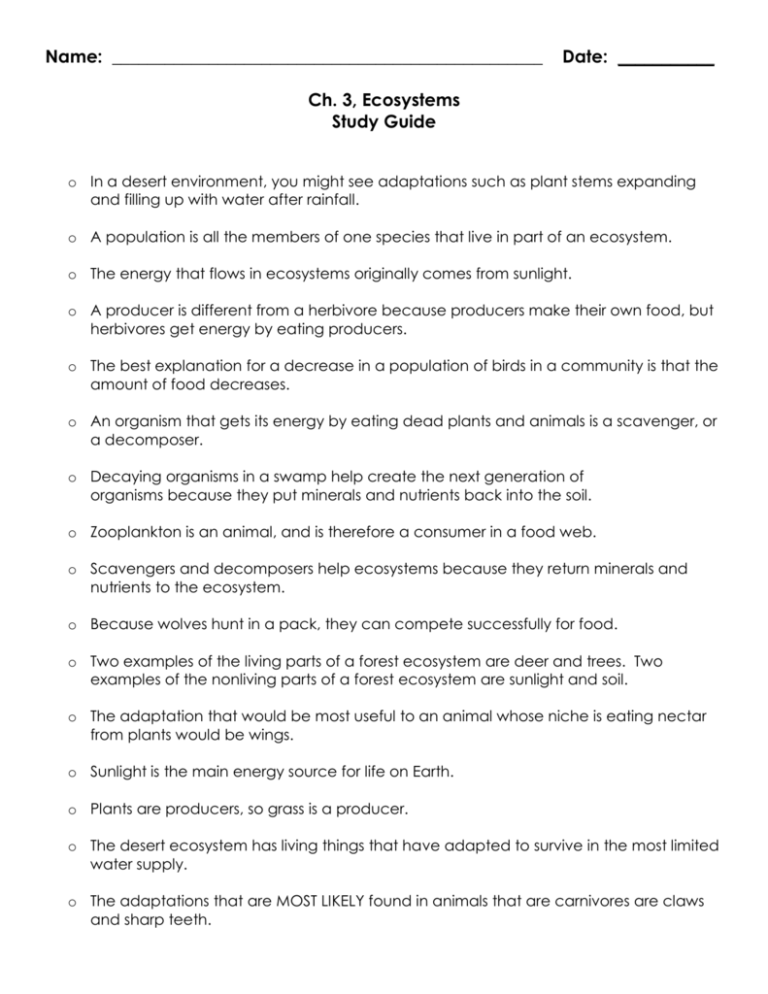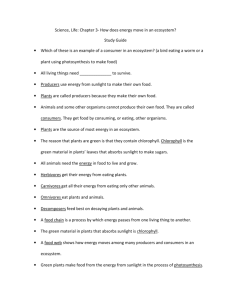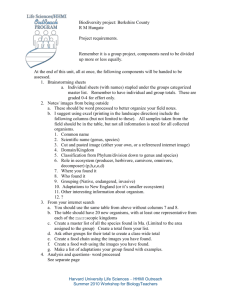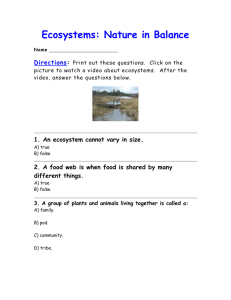Name: Date: ______ Ch. 3, Ecosystems Study Guide
advertisement

Name: _________________________________________________ Date: ___________ Ch. 3, Ecosystems Study Guide o In a desert environment, you might see adaptations such as plant stems expanding and filling up with water after rainfall. o A population is all the members of one species that live in part of an ecosystem. o The energy that flows in ecosystems originally comes from sunlight. o A producer is different from a herbivore because producers make their own food, but herbivores get energy by eating producers. o The best explanation for a decrease in a population of birds in a community is that the amount of food decreases. o An organism that gets its energy by eating dead plants and animals is a scavenger, or a decomposer. o Decaying organisms in a swamp help create the next generation of organisms because they put minerals and nutrients back into the soil. o Zooplankton is an animal, and is therefore a consumer in a food web. o Scavengers and decomposers help ecosystems because they return minerals and nutrients to the ecosystem. o Because wolves hunt in a pack, they can compete successfully for food. o Two examples of the living parts of a forest ecosystem are deer and trees. Two examples of the nonliving parts of a forest ecosystem are sunlight and soil. o The adaptation that would be most useful to an animal whose niche is eating nectar from plants would be wings. o Sunlight is the main energy source for life on Earth. o Plants are producers, so grass is a producer. o The desert ecosystem has living things that have adapted to survive in the most limited water supply. o The adaptations that are MOST LIKELY found in animals that are carnivores are claws and sharp teeth. o Plants are producers and they change energy from sunlight into chemical energy. o A food web is a group of overlapping food chains. o Green plants change sunlight into a usable energy source by making food through photosynthesis. o A decomposer is an organism like an insect that eats the wastes or remains of dead plants or animals. o A community is the different populations that interact in an area of an ecosystem. o Organisms living in a tundra ecosystem need to adaptations to a cold, dry climate where the ground is frozen year-round to survive. o If most of a population of animals dies of disease, the food web must change. o An omnivore is an animal that eats plants and animals. o Nutrients and minerals (energy) that animals need travel through a food chain. o A prairie dog’s burrow is its habitat. o A food chain shows the direction of energy flow in an ecosystem. o A food chain is different from a food web because in food webs, there are several overlapping food chains. o The difference between herbivores and omnivores is that both get energy by eating plants, but omnivores also eat animals. o An ecosystem is best described as a system where living and nonliving things interact. o The most important reason to store food in a refrigerator is because food decays more slowly in colder temperatures. *** BE SURE TO STUDY THE DEFINITIONS OF THE VOCABULARY TERMS FOR CHAPTER 3: ecosystem niche herbivore decomposer population omnivore community carnivore









